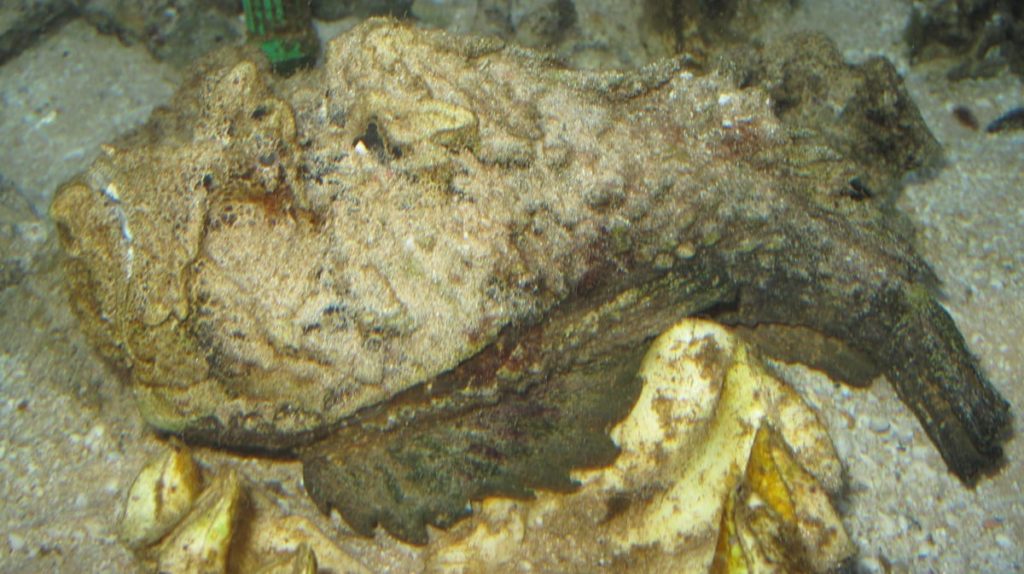Stonefish
The family Scorpaenidae (Scorpionfish) contains around 45 genera and 380 species. Scorpionfishes have large, heavily ridged heads and venomous spines on their back and fins. They are generally well camouflaged with tassels, warts and colored specks and some scorpionfishes (but not stonefish) can change their color to better match their surroundings. Most scorpion fishes live on or near the bottom of the ocean floor and can be found all around the world including from the Red Sea, Pacific Ocean, Australia, Hawaii and the Caribbean.
They feed on crustaceans, cephalopods and fishes employing a lie-in-wait strategy, remaining stationary and snapping prey that comes near. With their mouth they create a vacuum and suck prey in during a nearly imperceptible split-second movement (15 milliseconds).
Scorpionfishes are not aggressive, but if threatened they will erect their dorsal spines. If danger continues they flee, usually very fast but only for a short distance and then quickly settle back and freeze. The stonefishes for example usually bury themselves in sand or rubble using a shoveling motion of their pectoral fins. In a matter of less than 10 seconds only the dorsal portion of the head remains exposed, some sand is thrown on top to further enhancing concealment.
Scorpaenidae family includes:
- Scorpionfish
- Stonefish (Synanceia verrucosa and Synanceia horrida) – the worlds most venomous fish
- Lionfish or Turkeyfish (Dendrochirus and Pterois)
- Stingfish (Choridactylus)
- Spiny devilfish (Inimicus didactylus)
- Devilfishes (also called sea goblins, bearded ghouls and demon stingers) have very special pectoral fin rays that can be moved independently from the rest of the fin. This looks as if the devilfish was walking over the ground. Devilfishes occur on sand and mud bottoms close to reefs and in seagrass meadows. They often bury themselves in the substrate.
Stonefish (Synanceia verrucosa)
The stonefish is the worlds most venomous fish. Stonefish are extremely well camouflaged reef fish found in the waters of northern Australia. Their dorsal spines contain venom, which is injected when external pressure is applied. It is extremely difficult to see because it usually buries most of its body under sand or rubble and only their widely separated eyes show. Often algae and hydroids grow on its back. There is some suggestion that stonfishes exude a white, milky substance over their bodies which encourages plant growth. Their near perfect camouflage and the venomous spines make them a hazard for swimmers, snorkelers and divers in shallow water.
Resus
- Not life threatening
Risk Assessment
Geographical distribution includes the northern shore of Australia, North of Geraldton on the West and North of Brisbane on the East.
Typical symptoms include:
- Intense pain at the sting site.
- Local swelling and bruising maybe seen. Also inspect the area for a retained spine
- Systemic features can include nausea, vomiting, dizziness and dyspnoea
- Rarely patients can develop hypotension, bradycardia, collapse, pulmonary oedema and cyanosis
Supportive Care
- Hot water Place affected area in a shower or a bowl of hot water – approx 45 degrees, should be hot but not scalding or uncomfortable for 20 minutes.
- Analgesia Simple analgesia such as paracetamol and ibuprofen.
- If pain is refractory to the above treatment then IV morphine or equivalent opiates maybe required. Other strategies may involve regional blocks with a long acting anaesthetic. If you have anaesthetised the skin and are still using hot water therapy – make sure there is another limb in the water to make sure you are not causing secondary burns.
- The use of antibiotics is controversial but there is potential risk of a marine infection, a discussion with the patient re: observation or prophylactic antibiotics would be reasonable
Investigations
- May require an X-ray or ultrasound to look for a retained foreign body.
Differential Diagnosis:
- Other fish stings or stingray injuries
Antivenom
- CSL stonefish antivenom is used if the patient is refractory to IV opioid analgesia, regional block or has features of systemic envenomation. See link for further details.
- Give 1 ampoule for every two spine puncture wounds to a maximum of 3 ampoules, undiluted IM injection or diluted in 100ml of 0.9% saline IV over 20 minutes (we do not know whether it is best to give the antivenom IV or IM).
Disposition
- If there are no signs of systemic envenomation by two hours the patient can be discharged.
- If requiring IV opiates or antivenom the patient should be observed for four hours to see if they remain asymptomatic
- All patients should be warned about the risk of infection and to look for signs of secondary infection.
References and Additional Resources:
Additional Resources:
References:
- Lee JYL, Tech LC, Leo SPM. Stonefish envenomation of the hand – a local marine hazard. A series of 8 cases and review of the literature. Annals of the Academy of Medicine Singapore 2004; 33:515-520
- Little M. Stonefish (Syanceia species) sting. Emergency Medicine 1990; 2(4):5
- Ngo SYA, Ong SHJ, Ponampalam R. Stonefish envenomation presenting to a Singapore hospital. Singapore Medical Journal 2009; 50:506-509
- White J. A clinician’s guide to Australian venomous bites and stings: Incorporating the updated CSL antivenom handbook. Melbourne: CSL Ltd, 2012

Toxicology Library
TOXINS
Dr Neil Long BMBS FACEM FRCEM FRCPC. Emergency Physician at Kelowna hospital, British Columbia. Loves the misery of alpine climbing and working in austere environments (namely tertiary trauma centres). Supporter of FOAMed, lifelong education and trying to find that elusive peak performance.

